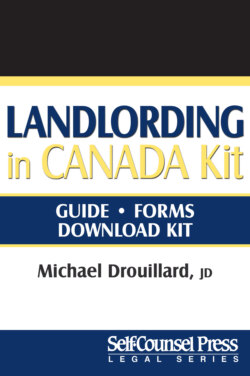Читать книгу Landlording in Canada - Michael Drouillard - Страница 20
На сайте Литреса книга снята с продажи.
Chapter 2 SECONDARY SUITES: PREVENTING PROBLEMS BEFORE THEY START
ОглавлениеIn this chapter, you will learn to:
• Plan in advance to address common secondary suite problems.
• Ensure your space is livable (and large enough!) before deciding to rent it out as a suite.
• Soundproof between units: Install insulation and carpet, and include noise reduction practices in the rental agreement.
• Be clear about the use of shared facilities and common space; include terms for its use in the rental agreement.
• Make a contingency plan if the electrical panel, hot water tank, or furnace are located within the secondary suite: The need may arise to access them.
• Contract out property maintenance such as lawn mowing and gutter cleaning: Do not make this a tenant’s responsibility.
• Include the cost for utilities in each month’s rent: Serve a tenant notice about reasonable utility use in case use gets excessive.
Secondary suites (also known as in-law suites, mortgage helpers, basement suites and in some cases, illegal suites or unauthorized accommodation, since they are commonly prohibited by local bylaws) have gone from fringe to mainstream in the past few decades. There are now hundreds of thousands (if not millions) of homes in Canada containing one or more secondary suites. In some areas, it is even standard practice to build homes designed to contain a secondary suite. While municipal bylaws commonly prohibit them, more and more municipalities are choosing to look the other way when an illegal suite is brought to their attention. Secondary suites have become a reality on the Canadian real estate scene.
On the other hand, a fair number of municipalities do not look the other way and will impose significant fines when illegal secondary suites are brought to their attention. Do you live in a municipality where enforcement against them is active? If so, I don’t think renting out a secondary suite is worth the risk and stress.
Secondary suite landlords face a unique set of challenges, partly because single family homes with suites do not meet building code requirements for multi-family property. For example, excessive sound transfer between suites and determining how to collect utility payments when two or more families share an electric/gas meter might seem minor at first, but issues such as these might result in serious disputes between the landlord and tenant.
There are other specific secondary suite- related issues to be discussed in this book. For instance, if you must evict the tenant living in your basement suite, what legal recourse do you have? Although some believe that secondary suite landlords don’t have the same legal rights as other tenants and landlords, know that legal secondary suite landlords and tenants are fully protected by provincial tenancy law.
Before you advertise your secondary suite, consider these proactive recommendations to address common secondary suite challenges. While you may not find a perfect solution to every problem, it’s far wiser to plan than to do nothing at all.
Ethical landlording tip: Would you live in your secondary suite? Some landlords carve suites out of sections of their home where there really shouldn’t be a suite at all. If your basement is below grade and windowless, for instance, then you have storage and workshop space, not potential living accommodation. Other landlords will convert a single family home into three, or even four separate rental units by illegally converting the garage, and even the crawlspace (I’ve seen ads on the Internet that blatantly advertise that tenants must be under six feet tall) into living space.
It’s not acceptable for three or more families to share a single hot water tank and heating system. Turnover is almost always constant. Neighbours will be forced to deal with four times the amount of garbage, noise, and vehicles. Landlords who brazenly impose themselves on the limits of their neighbourhoods are behaving unethically.
